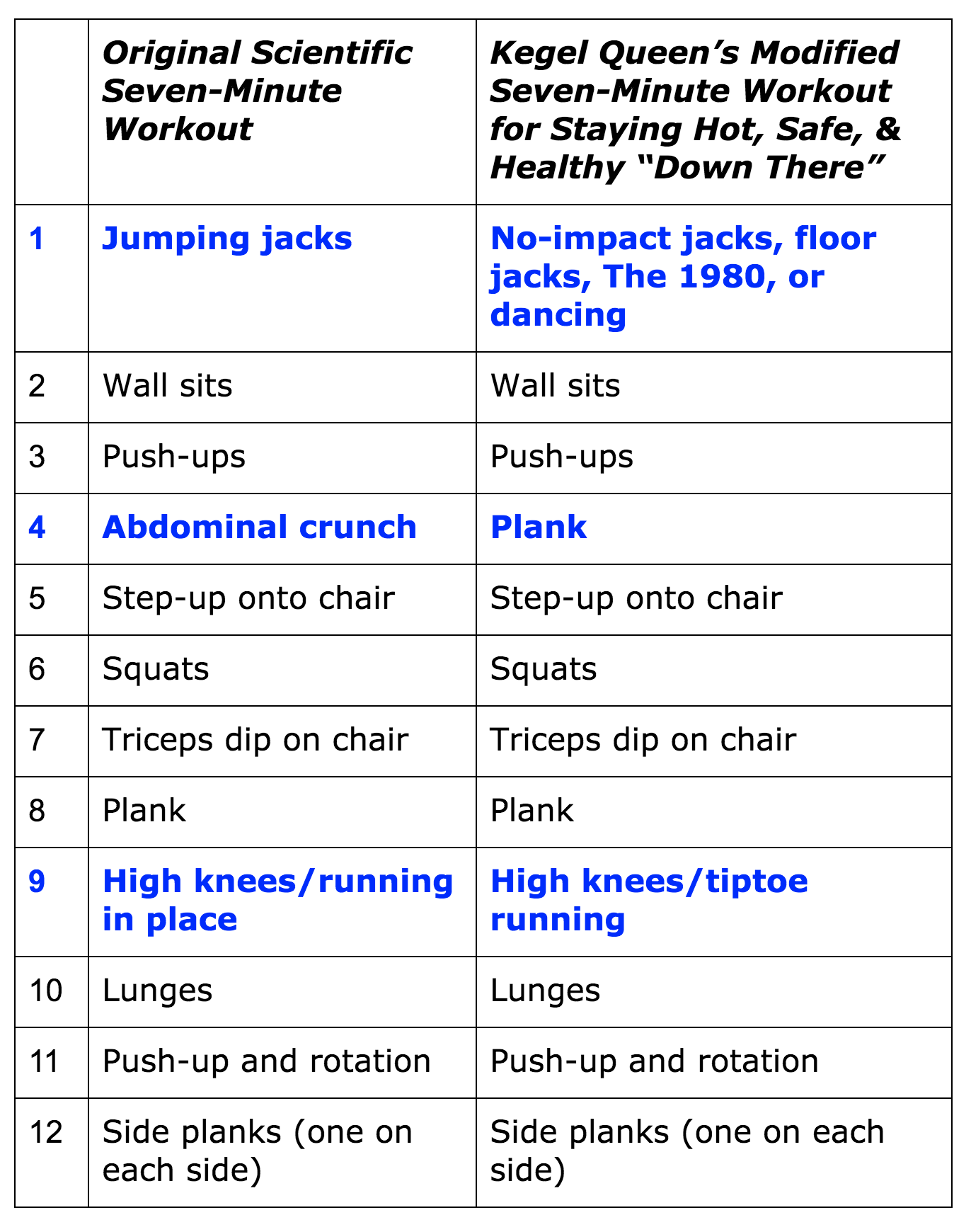
My number one secret to staying in shape? Short workouts. A few minutes of strength training in the morning (in my home office, usually in my pajamas) is something I can easily commit to and easily achieve. And I’m thrilled with the results: this is the strategy that got me, in my mid-forties, into the best shape of my life.
Recently I’ve been looking for a way to optimize my workouts for maximum strength and cardio benefits in minimum time, so I am thrilled to discover the popular Scientific Seven-Minute Workout.
There’s a lot to love about this workout:
* Like the Kegel Queen Program, it’s based on research about what actually works, not some random stuff people happened to think up.
* It’s accessible and achievable. Barriers to trying it are low. You don’t need any special exercise equipment. And although it’s great to do the workout two or three times for a 14- or 21-minute workout, pretty much anyone can find seven tiny minutes to exercise.
* Demonstrated health benefits of this type of training (High Intensity Circuit Training, HICT) include fat loss, reduced insulin resistance, and better cardiopulmonary function.
* The level of difficulty automatically matches your individual level of fitness. No matter where you are, you’re working at whatever is the peak level for you at that time. While I’m working out at my peak-intensity level, the fitness model in the video I’m using is doing the same exercises at twice my speed. We’re both getting an intensive workout doing the exact same moves, in spite of our very different fitness levels.
* This workout builds your muscles and makes you look good! Michelle Obama arms, anyone? Sign me up!
But there’s one HUGE problem with the Scientific Seven-Minute workout: some of the exercises can damage the pelvic floor. And this can lead to significant health problems for women, like vaginal prolapse (cystocele, rectocele, or uterine prolapse — this means your organs are literally falling out of their proper place into the vagina) or can make prolapse worse. Pelvic floor damage can bring on urinary incontinence, a.k.a. peeing your pants. And perhaps worst of all, pelvic floor problems can cause problems with sex. That means after your workouts you might look sexy, but things don’t work that great down there when it’s time to get down to business. Ouch!
The point of working out is to feel great, be strong and capable, and look hot. Right? And there’s nothing that says strong, sexy, and feeling good like adult diapers, or strange new bulges in your vagina… NOT!
The bad news is that pelvic floor damage from exercise is common. Women tell me all the time, “Things just aren’t the same ‘down there’ since I started xyz workout.”
The good news is that pelvic floor injury from exercise is totally preventable. And prevention is totally easy — if you know what to do. Please, keep your girl parts safe!
Here’s how I’ve modified the Scientific Seven-Minute Workout to be safer for my pelvic floor, and yours.
- [Exercise 1] Instead of jumping jacks, do “no-impact jacks” or another no-impact whole-body warm-up.
Options:
No-impact jacks: Do the usual jumping jack arm movements, but keep your feet planted and do half squats.
Floor jacks: Do “jumping jacks” while lying on the floor, as if you’re making a snow angel.
The 1980 (my favorite): I don’t know if Jane Fonda or Richard Simmons ever used this specific move, but to me it looks like textbook 1980 aerobics. Move your arms as in jumping jacks. As your arms go up, bring one knee up toward your chest. Alternate knees, so you’re high-stepping in rhythm with your arms.
Dance: Any whole-body dance move that keeps your arms and legs moving is fine, as long as arms and legs are making large movements for the full 30 seconds. Have fun!
- [Exercise 4] Replace crunches with a plank.
Crunches or sit-ups in any form are what I call Pelvic Enemy Number One. This is the move, more than any other, that can blow out your pelvic floor. Please, please, do not do sit-ups or crunches in any form. Do a plank.
Yes, I know that means you’ll be repeating an exercise, doing planks twice in the workout. That’s completely fine.
Women often try to bargain with me about giving up crunches. What about THIS crunch variation, is that OK?
No, I’m sorry, it’s not. No form of sit-up or crunch is safe for your girl parts.
And no, crunches don’t target-reduce belly fat. Crunches don’t give you more ripped abs than doing planks will. Also, crunches aren’t functional: they don’t mimic, or prepare you for, strength moves you will do in real life, like lifting heavy things. But crunches work your core! Yes, they do, in a completely unnatural way. There are other core exercises that are not only safer, but more effective — like planks.
- [Exercise 9] Run on tiptoe.
This isn’t technically a modification of the original program, but an important clarification. The original program calls the ninth exercise “High knees/running in place.” “High knees” is a low-impact move in which you’re focused on… wait for it… bringing your knees high. But if the workout guide you’re using calls this exercise “running in place,” most people will run with knees low and slam their feet into the floor. You guessed it, slamming your feet into the floor is a high-impact move, and high impact is bad for your pelvic floor. When you do this move, bring your speed up as high as you can without increasing impact. You won’t look like a badass Olympic runner; you will look like a dancing fairy who had way too much coffee. And for 30 seconds while you work out, that’s OK.

Want more info about how to keep your girl parts out of trouble? Check out my free webinar. And there’s lots more whole-body exercise info in the Kegel Queen program, available to you when you join as a member. Your first step to find out more about the program is my free webinar — check it out here.
Links
The Kegel Queen’s favorite seven-minute workout video
Original American College of Sports Medicine publication about the Seven-Minute Workout
Is the Kegel Queen Program right for you? Find out with this easy, free webinar.

